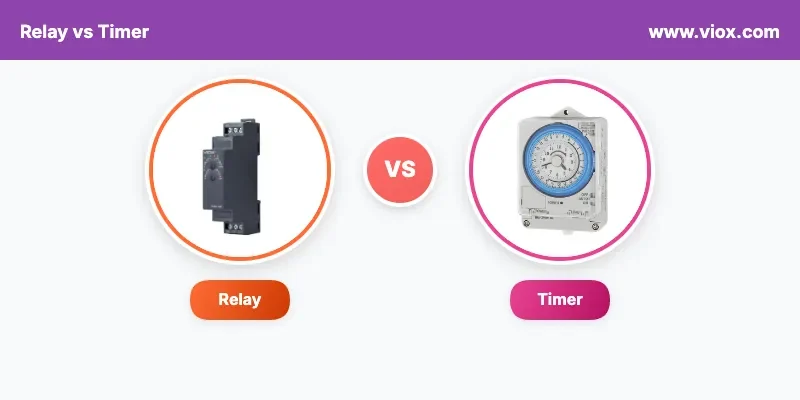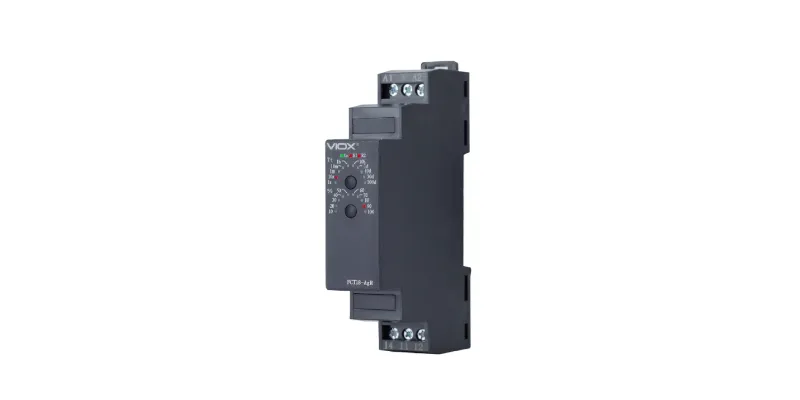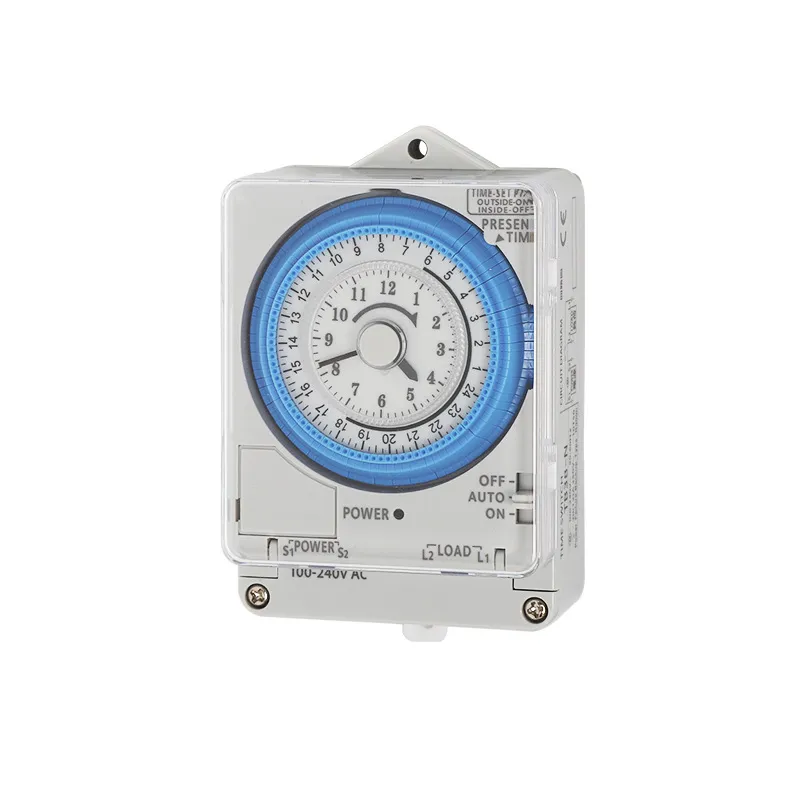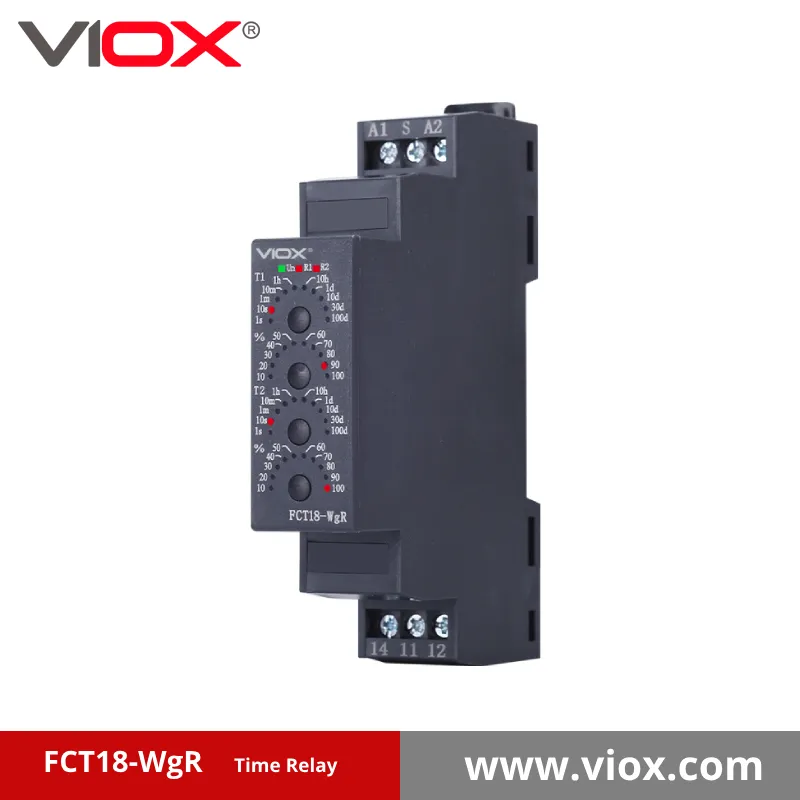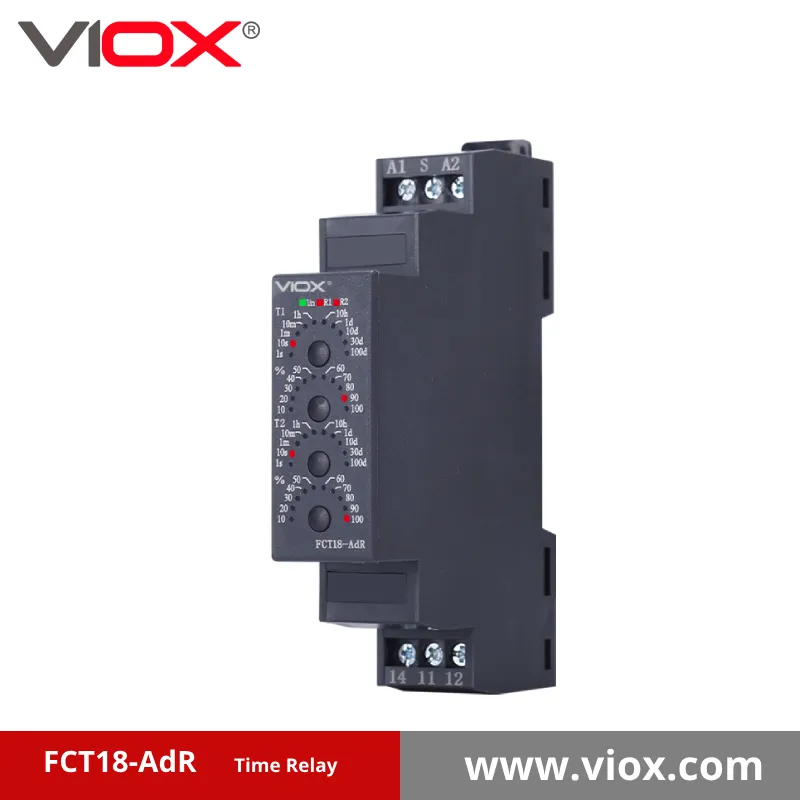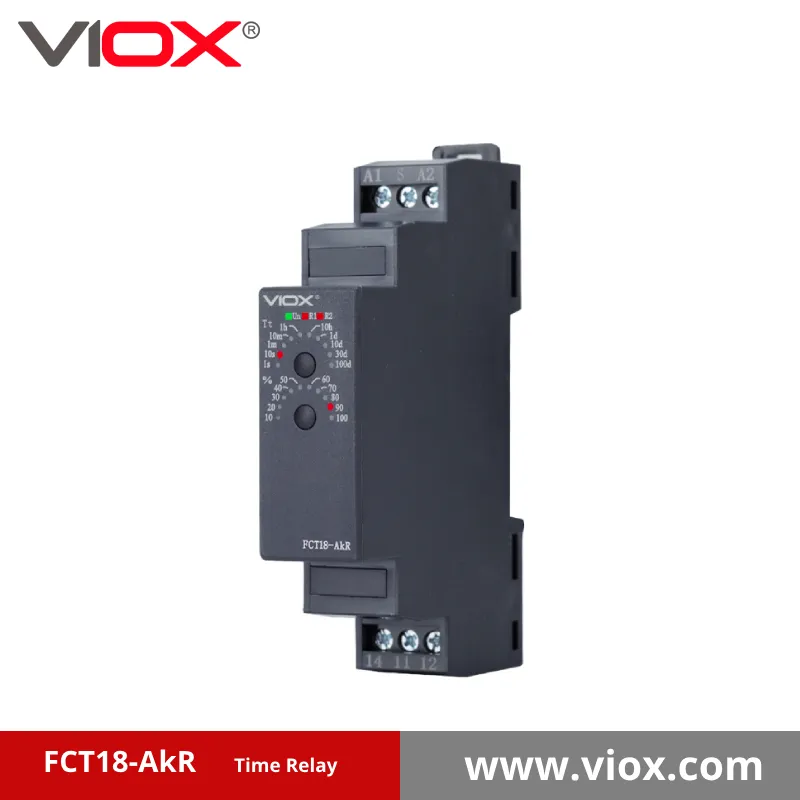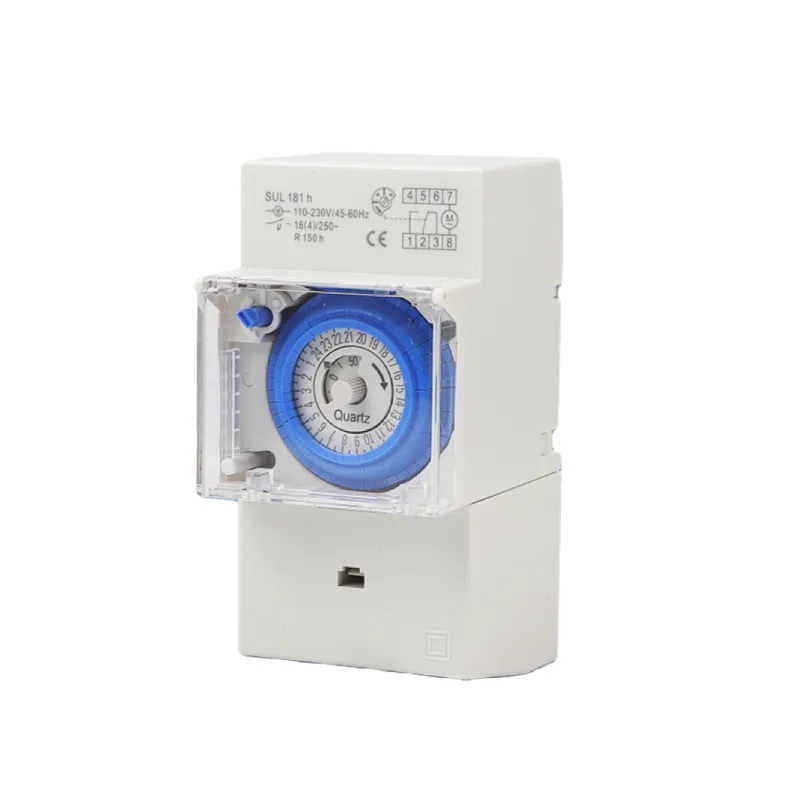Een relais is een elektrisch bediende schakelaar die één circuit aanstuurt door contacten in een ander circuit te openen of te sluiten. Een timer is een apparaat dat elektrische circuits aanstuurt op basis van vooraf ingestelde tijdsintervallen. Beide apparaten zijn essentiële onderdelen van elektrische besturingssystemen, maar ze vervullen duidelijk verschillende functies die bepalen wanneer en hoe u elk apparaat moet gebruiken.
Het begrijpen van het verschil tussen relais en timers is cruciaal voor iedereen die werkt met elektrische besturingssystemen, automatiseringsapparatuur of industriële toepassingen. Deze uitgebreide gids helpt u de juiste keuze te maken voor uw specifieke toepassing en tegelijkertijd de veiligheid en naleving van de regelgeving te garanderen.
Wat is een relais?
A relais is een elektromagnetische schakelaar die een kleine elektrische stroom gebruikt om een veel grotere stroom in een apart circuit te regelen. Wanneer de relaisspoel stroom ontvangt, creëert deze een magnetisch veld dat metalen contacten fysiek beweegt om elektrische verbindingen te openen of te sluiten.
Kenmerken van het sleutelrelais:
- Directe werking wanneer de stroom wordt ingeschakeld of uitgeschakeld
- Elektrische isolatie tussen regel- en geschakelde circuits
- Meerdere contactconfiguraties (normaal open, normaal gesloten, overgang)
- Huidige versterking vermogen (kleine stuurstroom schakelt grote belastingstroom)
- Geen timingfunctie ingebouwd in basisrelais
Wat is een timer?
A timer is een tijdvertragingsapparaat die regelt wanneer elektrische circuits in- of uitschakelen op basis van vooraf ingestelde tijdsintervallen. Timers kunnen de activering van apparatuur vertragen, bepalen hoe lang apparaten werken of specifieke tijdreeksen creëren in geautomatiseerde systemen.
Belangrijkste kenmerken van de timer:
- Tijdgebaseerde controle met instelbare vertragingen
- Verschillende timingfuncties (vertraagd, vertraagd, interval, herhaalcyclus)
- Digitale of analoge tijdinstelling mechanismen
- Ingebouwde timingcircuits met behulp van elektronische of mechanische methoden
- Programmeerbare timingsequenties in geavanceerde modellen
Relais versus timer: uitgebreide vergelijking
| Functie | Relais | Timer |
|---|---|---|
| Primaire functie | Elektrische schakeling | Tijdgebaseerde controle |
| Werkingssnelheid | Onmiddellijk (milliseconden) | Vertraagd (seconden tot uren) |
| Controlemethode | Aanwezigheid/afwezigheid van spanning | Vooraf ingestelde tijdsintervallen |
| Circuitisolatie | Ja, volledige isolatie | Verschilt per ontwerp |
| Timingcapaciteit | Geen (basisrelais) | Kernfunctionaliteit |
| Stroomverbruik | Laag wanneer geactiveerd | Continu tijdens de timing |
| Complexiteit | Eenvoudig elektromagnetisch apparaat | Complexe timingcircuits |
| Kosten Bereik | $5-50 (basismodellen) | $25-500+ (afhankelijk van de functies) |
| Typische toepassingen | Motorbesturing, verlichtingsschakeling | Vertragingscircuits, automatiseringssequenties |
| Complexiteit van installatie | Eenvoudige bedrading | Kan programmering vereisen |
Toepassingen en gebruikssituaties
Wanneer relais gebruiken
Relais zijn ideaal voor toepassingen waarbij het volgende vereist is:
- Motor starten en stoppen
- Grote motoren aansturen met kleine bedieningsschakelaars
- Bescherming van regelcircuits tegen hoge motorstromen
- Het op afstand bedienen van de motor mogelijk maken
- Systemen voor verlichtingsbeheer
- Het schakelen van verlichting met hoog wattage van laagspanningsregelaars
- Het creëren van verlichtingszones in commerciële gebouwen
- Koppeling met gebouwautomatiseringssystemen
- Veiligheidsvergrendelingen
- Noodstopcircuits
- Deurvergrendelingssystemen
- Machineveiligheidscontroles
- Signaalversterking
- Het omzetten van sensorsignalen met lage stroomsterkte om hoogvermogenbelastingen te schakelen
- Interfacing tussen verschillende spanningssystemen
- Meerdere uitgangen creëren vanuit één ingang
Wanneer timers gebruiken
Timers zijn essentieel voor toepassingen waarbij het volgende vereist is:
- Vertraagde start van apparatuur
- HVAC-systeemstaging om gelijktijdig opstarten te voorkomen
- Pompregeling in watersystemen
- Verlichtingsvertragingscircuits
- Automatische uitschakeling van apparatuur
- Timers voor het nadraaien van de ventilatoren nadat de verwarmingssystemen zijn uitgeschakeld
- Pomp-uitlooptimers voor resterende vloeistof
- Time-outfuncties voor veiligheidsuitrusting
- Procesbesturingssequenties
- Timing van productieapparatuur
- Chemische mengprocessen
- Geautomatiseerde assemblagelijnbesturing
- Energiebeheer
- Geplande apparatuurbediening
- Vermindering van de piekvraag
- Automatische lichtregeling
Soorten relais en timers
Estafettecategorieën
| Type | Beschrijving | Typische toepassingen |
|---|---|---|
| Algemeen doel | Basis SPDT/DPDT contacten | Verlichting, kleine motoren |
| Vermogensrelais | Hoge stroomcapaciteit | Grote motoren, verwarmingselementen |
| Veiligheidsrelais | Gedwongen contacten | Noodstopsystemen |
| Vaste toestand | Geen bewegende delen | Frequente schakeltoepassingen |
| Vergrendeling | Handhaaft positie zonder kracht | Energiebesparende toepassingen |
Timercategorieën
| Type | Beschrijving | Timing Bereik |
|---|---|---|
| Vertraging | Vertraagt het inschakelen na trigger | 0,1 sec – 24 uur |
| Uitschakelvertraging | Vertraagt het uitschakelen nadat de trekker is verwijderd | 0,1 sec – 24 uur |
| Interval | Gaat voor een bepaalde periode aan en dan weer uit | 0,1 sec – 999 uur |
| Herhaalcyclus | Continue aan/uit-cyclus | Variabele cycli |
| Multifunctioneel | Programmeerbare timingmodi | Zeer variabel |
Selectiecriteria en tips van experts
Het kiezen van het juiste relais
Belangrijke factoren om te overwegen:
- Contact Configuratie
- Bepaal hoeveel circuits u moet besturen
- Overweeg normaal open versus normaal gesloten vereisten
- Met het oog op toekomstige uitbreiding moet
- Stroom- en spanningswaarden
- Grootte van de contacten voor de werkelijke belastingstroom plus de veiligheidsmarge van 25%
- Controleer of de spoelspanning overeenkomt met het regelcircuit
- Houd rekening met de inschakelstroom voor motorbelastingen
- Milieuvereisten
- Kies de juiste behuizingsklasse (NEMA 1, 4, 7, enz.)
- Houd rekening met extreme temperaturen en vochtigheid
- Houd rekening met trillingen in industriële toepassingen
💡 Experttip: Gebruik bij motoren van meer dan 1 pk altijd contactors in plaats van universele relais, om een goede boogonderdrukking en een lange levensduur van de contacten te garanderen.
De juiste timer kiezen
Kritische selectieparameters:
- Timingfunctie nodig
- Bepaal of u timing met vertraging, vertraging of interval nodig hebt
- Overweeg multifunctionele timers voor complexe sequenties
- Evalueer de behoefte aan handmatige override-mogelijkheden
- Tijdsbereikvereisten
- Selecteer een timer met de juiste minimale en maximale tijdinstellingen
- Houd rekening met mogelijke toekomstige timingaanpassingen
- Overweeg of digitale of analoge aanpassing de voorkeur heeft
- Compatibiliteit van de voeding
- Controleer of de timer werkt op de beschikbare stuurspanning
- Houd rekening met het stroomverbruik tijdens tijdsperiodes
- Houd rekening met de vereisten voor noodstroomvoorziening indien van toepassing
💡 Experttip: Gebruik elektronische timers in plaats van mechanische timers bij toepassingen waarbij frequente tijdaanpassingen of een hoge precisie vereist zijn.
Veiligheidsoverwegingen en naleving van de code
Elektrische veiligheidseisen
⚠️ Kritische veiligheidswaarschuwing: Volg altijd NEC (Nationale Elektrische Code) Vereisten bij het installeren van relais en timers. Onjuiste installatie kan leiden tot schade aan de apparatuur, brand of persoonlijk letsel.
Essentiële veiligheidspraktijken:
- Gebruik voor alle circuits een overstroombeveiliging met de juiste classificatie
- Zorg voor voldoende kabelafmetingen voor aangesloten belastingen
- Zorg voor een geschikte aarding conform NEC artikel 250
- Installeer vlamboogbeveiliging waar vereist door de lokale regelgeving
Vereisten voor professionele installatie
Wanneer u een gecertificeerde elektricien moet inschakelen:
- Elke installatie waarbij spanningen boven 50V voorkomen
- Commerciële of industriële toepassingen
- Integratie met brandveiligheids- of beveiligingssystemen
- Aanpassing van bestaande elektrische panelen
Problemen oplossen
Relaisproblemen en oplossingen
| Probleem | Mogelijke oorzaak | Oplossing |
|---|---|---|
| Relais wordt niet geactiveerd | Geen spoelspanning | Controleer de bedrading van het regelcircuit |
| Contacten lassen dicht | Overmatige inschakelstroom | Installeer een stroombegrenzer of gebruik een contactor |
| Spoel brandt door | Overspanningstoestand | Controleer de voedingsspanningswaarden |
| Onregelmatige werking | Slechte verbindingen | Maak alle aansluitingen schoon en draai ze vast |
Timerproblemen en oplossingen
| Probleem | Mogelijke oorzaak | Oplossing |
|---|---|---|
| Timing onnauwkeurig | Temperatuureffecten | Gebruik een temperatuurgecompenseerde timer |
| Timer start niet | Ingangssignaal te kort | Controleer de minimale pulsbreedtevereisten |
| De timing verandert in de loop van de tijd | Componentveroudering | Timer kalibreren of vervangen |
| Beeldscherm werkt niet | Problemen met de stroomvoorziening | Controleer de juiste voedingsspanning |
Kostenanalyse en ROI-overwegingen
Initiële investeringsvergelijking
Basis relaissystemen:
- Eenvoudig relais: $10-25
- Installatiekosten: $50-100
- Totale projectkosten: $60-125
Basis timersystemen:
- Elektronische timer: $50-150
- Installatie en programmering: $100-200
- Totale projectkosten: $150-350
Langetermijnwaardebeoordeling
Voordelen van relais:
- Lagere initiële kosten
- Minimale onderhoudsvereisten
- Lange levensduur (typisch 10+ jaar)
- Eenvoudige vervangingsprocedures
Voordelen van de timer:
- Energiebesparing door geoptimaliseerde regeling
- Minder handmatige bedieningsvereisten
- Verbeterde procesconsistentie
- Verbeterde mogelijkheden voor systeemautomatisering
Beste praktijken voor installatie
Richtlijnen voor relaisinstallatie
- Montage-oriëntatie
- Installeer relais indien mogelijk verticaal voor optimale contactprestaties
- Vermijd montage ondersteboven om contactlassen te voorkomen
- Zorg voor voldoende ventilatie rond de relaisbehuizing
- Bedradingspraktijken
- Gebruik de juiste draaddikte voor aangesloten lasten
- Implementeer overspanningsbeveiliging voor inductieve belastingen
- Label alle draden voor toekomstig onderhoud
- Testprocedures
- Controleer de spoelweerstand vóór installatie
- Test de contactwerking met een multimeter
- Controleer of het contact goed open en dicht gaat
Richtlijnen voor timerinstallatie
- Vereisten voor voeding
- Controleer de juiste spanning en frequentie
- Zorg voor een stabiele stroombron voor nauwkeurige timing
- Overweeg UPS-back-up voor kritieke toepassingen
- Programmeren en instellen
- Documenteer alle timinginstellingen voor toekomstig gebruik
- Test de timingnauwkeurigheid met een stopwatch tijdens de inbedrijfstelling
- Zorg voor schriftelijke bedieningsinstructies voor gebruikers
- Bescherming van het milieu
- Gebruik geschikte NEMA-geclassificeerde behuizingen
- Beschermen tegen elektromagnetische interferentie
- Zorg voor voldoende temperatuurregeling in behuizingen
Veelgestelde Vragen
V: Kan een relais timingfuncties uitvoeren?
A: Standaardrelais bieden geen timingfuncties. Tijdvertragingsrelais combineren echter relaiscontacten met ingebouwde timingcircuits, waardoor ze zowel schakel- als timingfuncties in één apparaat bieden.
V: Wat is het verschil tussen mechanische en elektronische timers?
A: Mechanische timers maken gebruik van uurwerkmechanismen en zijn minder nauwkeurig, maar beter bestand tegen elektrische interferentie. Elektronische timers bieden een hogere precisie, meer functies en programmeerbare functies, maar kunnen last hebben van problemen met de stroomkwaliteit.
V: Hoe weet ik of ik een relais of een timer nodig heb voor mijn toepassing?
A: Als u direct wilt schakelen op basis van een ingangssignaal, gebruik dan een relais. Als u wilt bepalen wanneer iets gebeurt op basis van tijdsintervallen, gebruik dan een timer. Overweeg voor beide functies een tijdvertragingsrelais of een programmeerbare besturingsmodule.
V: Op welke veiligheidscertificeringen moet ik letten?
A: Zoek naar een UL-vermelding (Underwriters Laboratories) voor Noord-Amerika, CE-markering voor Europa en CSA-goedkeuring (Canadian Standards Association) waar van toepassing. Industriële toepassingen vereisen mogelijk aanvullende certificeringen, zoals explosieveiligheidsclassificaties.
V: Kunnen timers en relais samen in hetzelfde systeem worden gebruikt?
A: Ja, timers en relais worden vaak samen gebruikt in complexe besturingssystemen. Timers zorgen voor de timinglogica, terwijl relais het daadwerkelijke schakelen van belastingen afhandelen, waardoor geavanceerde automatiseringsprocessen ontstaan.
V: Welk onderhoud hebben relais en timers nodig?
A: Relais moeten doorgaans na langdurig gebruik periodiek worden gereinigd en vervangen. Elektronische timers vereisen minimaal onderhoud, maar de timingnauwkeurigheid moet jaarlijks worden gecontroleerd. Beide moeten worden gecontroleerd op goede verbindingen en correcte montage.
V: Hoe bepaal ik de juiste maat relais voor het starten van motoren?
A: Selecteer voor het starten van de motor relaiscontacten die geschikt zijn voor minimaal 6 keer de maximale motorbelastingsstroom om de startstroom te verwerken. Nog beter is het om een motorstartercontactor te gebruiken die speciaal voor deze toepassing is ontworpen en voorzien is van de juiste overbelastingsbeveiliging.
V: Wat is de typische levensduur van relais vergeleken met timers?
A: Kwaliteitsrelais kunnen 10-15 jaar meegaan bij een correcte installatie en een geschikte belasting. Elektronische timers gaan doorgaans 15-20 jaar mee, terwijl mechanische timers afhankelijk van de gebruiksfrequentie mogelijk elke 8-12 jaar vervangen moeten worden.
De juiste keuze maken: Beslissingskader
Gebruik een relais wanneer:
- U heeft een onmiddellijke schakelrespons nodig
- Regel- en belastingcircuits vereisen isolatie
- Eenvoudige aan/uit-bediening is voldoende
- Kosten zijn een primaire zorg
- Er is een hoge stroomschakelcapaciteit nodig
Gebruik een timer wanneer:
- Tijdgebaseerde controle is vereist
- Geautomatiseerde sequenties zijn nodig
- Energiebeheer is belangrijk
- Procesoptimalisatie is een doel
- Apparatuurbeveiliging vereist tijdvertragingen
Overweeg gecombineerde oplossingen wanneer:
- Er zijn complexe besturingssequenties nodig
- Er zijn zowel onmiddellijke als vertraagde reacties nodig
- Er wordt een toekomstige systeemuitbreiding verwacht
- Integratie met gebouwautomatiseringssystemen is gepland
Aanbevelingen en Volgende Stappen
Voor een optimaal resultaat:
- Raadpleeg gekwalificeerde elektriciens voor installaties met hoge spanningen of complexe systemen
- Controleer de lokale elektrische voorschriften voordat u met de installatie begint
- Documenteer alle instellingen en configuraties voor toekomstig onderhoud
- Plan voor toekomstige uitbreiding door apparaten met extra capaciteit te selecteren
- Zorg voor een correcte etikettering voor alle besturingsapparaten en circuits
Een professioneel consult wordt aanbevolen voor:
- Industriële automatiseringssystemen
- Toepassingen voor levensveiligheid
- Integratie met bestaande gebouwbeheersystemen
- Toepassingen met hoge spanning of hoge stroom
- Toepassingen waarvoor specifieke industriële certificeringen vereist zijn
Door de fundamentele verschillen tussen relais en timers te begrijpen, kunt u effectievere besturingssystemen ontwerpen en tegelijkertijd de veiligheid en naleving van de regelgeving garanderen. Of u nu eenvoudige verlichtingscircuits of complexe industriële processen aanstuurt, het kiezen van het juiste apparaat voor elke toepassing is essentieel voor een betrouwbare en efficiënte werking.
Voor complexe toepassingen waarbij zowel directe schakeling als tijdgebaseerde besturing vereist is, kunt u overwegen om automatiseringsprofessionals te raadplegen die geïntegreerde oplossingen kunnen ontwerpen met behulp van programmeerbare logische controllers (PLC's) of andere geavanceerde besturingssystemen die de voordelen van zowel relais als timers combineren in geavanceerde besturingsarchitecturen.
Gerelateerd
Inzicht in de soorten en functies van tijdschakelaars & Toepassingen

